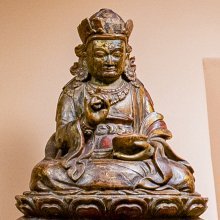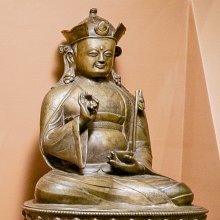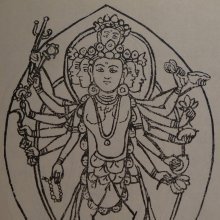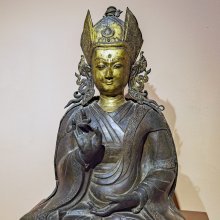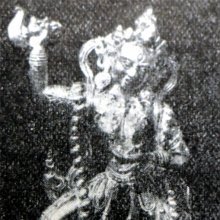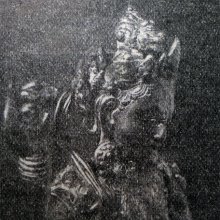Khatvanga, Khaṭvāṅga, Khatva-anga, Khatvamga: 27 definitions
Introduction:
Khatvanga means something in Buddhism, Pali, Hinduism, Sanskrit, Jainism, Prakrit, the history of ancient India. If you want to know the exact meaning, history, etymology or English translation of this term then check out the descriptions on this page. Add your comment or reference to a book if you want to contribute to this summary article.
Images (photo gallery)
(+5 more images available)
In Hinduism
Purana and Itihasa (epic history)
Source: Wisdom Library: Bhagavata PuranaKhaṭvāṅga (खट्वाङ्ग):—Son of Viśvasaha (son of Aiḍaviḍi). He had a son named Dīrghabāhu. (see Bhāgavata Purāṇa 9.9.41, 9.10.1)
Source: archive.org: Puranic EncyclopediaKhaṭvāṅga (खट्वाङ्ग).—General Information. A King of the Ikṣvāku dynasty, known by the name Dilīpa also. Bhāgavata Skandha 9, states that Khaṭvāṅga was the son of the grandson of Kalmāṣapāda. Aśmaka was the son of Kalmāṣapāda, Mūlaka the son of Aśmaka and Khaṭvāṅga the son of Mūlaka.
Khaṭvāṅga who was a royal hermit once pleased God and understood how long he would live. From that day onwards he left all the work of administration in the hands of ministers and spent the remaining days in devotion and meditation. (Bhāgavata, Skandha 2). Particular details. In Mahābhārata it is mentioned that Khaṭvāṅga was the son of the woman called Ilibilā and that he had the name Dilīpa also. Khaṭvāṅga was one of the sixteen famous Kings of Bhārata. The sixteen Kings were Marutta, Suhotra, Paurava, Śibi, Śrī Rāma, Bhagīratha, Khaṭvāṅga, (Dilīpa) Māndhātā, Yayāti, Ambarīṣa, Śaśabindu, Gaya, Rantideva, Bharata, Pṛthu and Paraśurāma. Khaṭvāṅga performed one hundred sacrifices. At the time of sacrifice he made golden roads. Even Indra came to the sacrifice. The Devas blessed Khaṭvāṅga on that day. See under Dilīpa. (Mahābhārata Droṇa Parva, Chapter 61). (See full article at Story of Khaṭvāṅga from the Puranic encyclopaedia by Vettam Mani)
Source: Cologne Digital Sanskrit Dictionaries: The Purana Index1a) Khaṭvāṅga (खट्वाङ्ग).—A son of Viśvasaha, and cakravartin. Fought for the devas and slew Daityas in battle. Knowing he had an hour of life left he returned and devoted himself to Nārāyaṇa in a detached spirit, and attained brahmaloka in a muhūrta. A Rājaṛṣi who sought refuge in Hari towards the end of his life. His son was Dīrgabāhu.*
- * Bhāgavata-purāṇa IX. 9. 41-49; II. 1. 13; XI. 23. 30; IX. 10. 1; Viṣṇu-purāṇa IV. 4. 76-83.
1b) A son of Yaśodā,1 a rājaṛṣi.2
1c) A daitya.*
- * Bhāgavata-purāṇa XII. 3. 9.
Khatvāṅga (खत्वाङ्ग) is the son of Viśvabāhu and grandson of Vṛddhaśarman, according to the Vaṃśānucarita section of the 10th century Saurapurāṇa: one of the various Upapurāṇas depicting Śaivism.—Accordingly, [...] From Nakula was born the celebrated king Śataratha. Ilavila was born of Śataratha. Ilavila’s son was Vṛddhaśarman who begot Viśvabāhu and the latter’s son was Khatvāṅga. Dīrghabāhu was born from Khatvāṅga and Raghu was the son of Dīrghabāhu.

The Purana (पुराण, purāṇas) refers to Sanskrit literature preserving ancient India’s vast cultural history, including historical legends, religious ceremonies, various arts and sciences. The eighteen mahapuranas total over 400,000 shlokas (metrical couplets) and date to at least several centuries BCE.
Vaishnavism (Vaishava dharma)
Source: VedaBase: Śrīmad BhāgavatamKing Khaṭvāṅga was unconquerable in any fight. Requested by the demigods to join them in fighting the demons, he won victory, and the demigods, being very pleased, wanted to give him a benediction. The King inquired from them about the duration of his life and was informed that he had only one moment more. Thus he immediately left his palace and went to his own residence, where he engaged his mind fully on the lotus feet of the Lord.
Source: ISKCON Press: GlossaryKhaṭvāṅga (खट्वाङ्ग).—A saintly king who is famous for attaining unalloyed Kṛṣṇa consciousness just moments before his death.

Vaishnava (वैष्णव, vaiṣṇava) or vaishnavism (vaiṣṇavism) represents a tradition of Hinduism worshipping Vishnu as the supreme Lord. Similar to the Shaktism and Shaivism traditions, Vaishnavism also developed as an individual movement, famous for its exposition of the dashavatara (‘ten avatars of Vishnu’).
Shilpashastra (iconography)
Source: Google Books: Elements of Hindu iconographyKhaṭvāṅga is a curious sort of club, made up of the bone of the forearm or the leg, to the end of which a human skull is attached through its foramen.
Source: Red Zambala: Hindu Icons and Symbols | IntroductionKhaṭvāṅga (club with skull) - Impermanence, dissolution, also represents the 8 mystical powers obtained through yoga meditation.

Shilpashastra (शिल्पशास्त्र, śilpaśāstra) represents the ancient Indian science (shastra) of creative arts (shilpa) such as sculpture, iconography and painting. Closely related to Vastushastra (architecture), they often share the same literature.
Shaivism (Shaiva philosophy)
Source: academia.edu: KāpālikasKhaṭvāṅga (खट्वाङ्ग, “hair jewel”) refers to a “skull-topped staff”.—Lākulas were also to carry a skull-topped staff (khaṭvāṅga) and to meditate on Rudra (see Śiva), who was to be seen as all things, and whose highest manifestation was considered to be Dhruva.
Source: Brill: Śaivism and the Tantric TraditionsKhaṭvāṅga (खट्वाङ्ग) refers to an attribute of one observing the raudravrata, according to the Kiraṇatantra chapter 49 (dealing with vratacaryā).—Accordingly, “Garuḍa spoke: ‘You have taught me, O great Lord, the activities of the Neophyte, the Putraka and the Ācārya. Tell me those of the Sādhaka’. The Lord spoke: ‘[...] This is the auspicious Raudra-vrata: imposing with a chignon of matted locks, marked by a trident and khaṭvāṅga, equipped with a clean half skull, awe-inspiring with a third eye, clothed in the skin of a tiger, peaceful. For one firm [in this observance], the highest siddhi will arise in six months; middling [powers] in four months; the lowest [powers] will arise in three months. [...]’”.
Source: SOAS University of London: Protective Rites in the Netra TantraKhaṭvāṅga (खट्वाङ्ग) refers to a “skull-topped staff”, according to the Netratantra of Kṣemarāja: a Śaiva text from the 9th century in which Śiva (Bhairava) teaches Pārvatī topics such as metaphysics, cosmology, and soteriology.—Accordingly, [verse 10.1-7ab, while describing the appearance and worship of Bhairava]—“[...] He [is] mounted on a lion, wears a snake garland, bears a mālā, and begging bowl. [He has] a torn mouth from [which he emits] a great roar. [His body is] covered by a cloth of elephant skin, a flower crown, [and] the moon. [Bhairava] holds a skull-topped staff (khaṭvāṅga) and skull bowl. [...] Having worshipped Bhairava, [the Mantrin] remembers being joined in union [with] him, [in the same way as] dissolution in fire”.

Shaiva (शैव, śaiva) or Shaivism (śaivism) represents a tradition of Hinduism worshiping Shiva as the supreme being. Closely related to Shaktism, Shaiva literature includes a range of scriptures, including Tantras, while the root of this tradition may be traced back to the ancient Vedas.
Shaktism (Shakta philosophy)
Source: Google Books: Manthanabhairavatantram1) Khaṭvāṅga (खट्वाङ्ग) refers to the “ascetic’s staff” and is used to describe Śaṃkara (i.e., Bhairava), according to the second recension of the Yogakhaṇḍa of the Manthānabhairavatantra, a vast sprawling work that belongs to a corpus of Tantric texts concerned with the worship of the goddess Kubjikā.—Accordingly, as the Goddess (i.e., Khageśī) said to the God (i.e., Bhairava), “[...] Give up the ash, the matted hair and the form with five faces. Give up the bones and skull and (all) else that is artificial. Give up (the practice of ritual) gestures, the Moon and the sacred thread. Give up the bull and the Ganges. Give up (your) spear and the great serpent, the ascetic’s staff [i.e., khaṭvāṅga] and, O god, the garland of severed heads and the skull. Accomplishment (siddhi) (can only be found) in Kula, Kaula and the Western (transmission) of Sadyojāta. [...]”.
2) Khaṭvāṅga (खट्वाङ्ग) refers to the “ascetic’s staff” and as one of the weapons (attributes) of Goddess Kubjikā symbolizes “the acquisition of the eight yogic powers”, according to the Manthānabhairavatantra.—Accordingly, “(Now) I will tell (you about) the great weapons of that (goddess) Kubjikā. [...] (One) attains (ultimate) reality by means of the trident and Māyā is destroyed by means of the wheel. All diseases are destroyed by the thunderbolt while the goad is considered to be (the means to attract and) control. The enemy is destroyed by the arrow. The dagger is the avoidance of obstacles. Wealth is acquired by means of the severed head and the eight yogic powers by the ascetic’s staff [i.e., khaṭvāṅga]”.

Shakta (शाक्त, śākta) or Shaktism (śāktism) represents a tradition of Hinduism where the Goddess (Devi) is revered and worshipped. Shakta literature includes a range of scriptures, including various Agamas and Tantras, although its roots may be traced back to the Vedas.
In Buddhism
Tibetan Buddhism (Vajrayana or tantric Buddhism)
Source: Google Books: VajrayoginiKhaṭvāṅga (खट्वाङ्ग).—Vajravārāhī’s third attribute is the skull staff (khaṭvāṅga) balanced upon her left shoulder. according to the 12th-century Abhisamayamañjarī: “On her left side resting on her arm, Vajravārāhī is visualized carrying a skull staff (khaṭvāṅga) whose nature is the means of enlightenment. It is brilliant with a white stock that has a single prong at its base and a black five-pronged vajra at its upper end, and beneath that vajra a desiccated human head, a fresh human head wet with blood, a pair of crossed vajras, a golden vase, and fluttering from the vase’s base, multicolored streamers with tiny tinkling bells.”
In illustrations, the “dry and wet heads” are usually depicted as whitisah-yellow for the upper head, and blood-red for the freshly severed lower head, although there is a good deal of variation in artistic works. The Kriyāsamuccaya distinguishes a different type of skull staff alotgether, with three dried heads. The equation of the skul lstaff with means (upāyasvabhāva) is a common one and identifies the staff with the male consort.
Source: academia.edu: The Structure and Meanings of the Heruka MaṇḍalaKhaṭvāṅga (खट्वाङ्ग) refers to a “skull staff” and represents one of the items held in the left hand of Heruka: one of the main deities of the Herukamaṇḍala described in the 10th century Ḍākārṇava chapter 15. Heruka is positioned in the Lotus (padma) at the center; He is the origin of all heroes; He has 17 faces (with three eyes on each) and 76 arms [holding, for example, khaṭvāṅga]; He is half black and half green in color; He is dancing on a flaming sun placed on Bhairava and Kālarātrī.
Source: OSU Press: Cakrasamvara SamadhiKhaṭvāṅga (खट्वाङ्ग) refers to a “staff” which is used to describe Cakrasaṃvara, according to the Saṃvaramaṇḍala of Abhayākaragupta’s Niṣpannayogāvalī, p. 45 and n. 145; (Cf. Cakrasaṃvaratantra, Gray, David B., 2007).—Accordingly, [while describing the iconography of Cakrasaṃvara]: “In the Saṃvara Maṇḍala atop Mount Sumera within a vajra-canopy there is a variegated lotus, on top of that a palace, in the middle of which is the Blessed Lord, standing in ālīḍhāsana, "archer's pose", [...] possessing a vyāghracarma, "tiger skin" and twelve arms, the foremost arms holding a vajra and ghaṇṭā, embracing Vajravārāhī, the uppermost arms holding a gajacarman, "elephant skin", dripping with blood, the remaining arms holding, starting second from the top, on the right, a ḍamaru, "double-headed drum", paraśu, "axe", kartika, "flaying knife", triśūla, "trident", on the left, a khaṭvāṅga, "staff", kapāla, "skull bowl", pāśa, "noose", and brahmamuṇḍa, "lopped head of Brahma", [...]”.
Note: [For Cakrasaṃvara]—The khaṭvāṅga, "staff", symbolizes letting go of the distinction between things being material (rūpa-loka) and immaterial (nāma-loka).—[For Vajravārāhī]—When alone, the khaṭvāṅga, "staff", represents Cakrasaṃvara, which symbolizes she is never separated from him. (the reverse is true for him when he is portrayed without her.)
Source: MDPI Books: The Ocean of HeroesKhaṭvāṅga (खट्वाङ्ग) refers to a “skull staff” (i.e., one of the attributes held in the hands of a deity), according to the 10th-century Ḍākārṇava-tantra: one of the last Tibetan Tantric scriptures belonging to the Buddhist Saṃvara tradition consisting of 51 chapters.—Accordingly, “[...] [He (The Causal Vajra-holder)] stands in the ālīḍha posture with the feet placed on both Hara and Gaurī [He holds] (1) a vajra and (2) a bell, (3)(4) an elephant’s skin, (5) a drum, (6) a knife, (7) an axe, (8) a trident, (9) a skull staff (khaṭvāṅga), (10) a pot, (11) a noose, and (12) a hairless head in the left and right [hands]. [...]”.

Tibetan Buddhism includes schools such as Nyingma, Kadampa, Kagyu and Gelug. Their primary canon of literature is divided in two broad categories: The Kangyur, which consists of Buddha’s words, and the Tengyur, which includes commentaries from various sources. Esotericism and tantra techniques (vajrayāna) are collected indepently.
In Jainism
General definition (in Jainism)
Source: archive.org: TrisastisalakapurusacaritraKhaṭvāṅga (खट्वाङ्ग) is the tree associated with the Rākṣasas, one of the eight divisions of the Vyantaras: a group of deities living above the Ratnaprabhā-earth in the “lower world” (adhaloka), according to chapter 2.2 [ajitanātha-caritra] of Hemacandra’s 11th century Triṣaṣṭiśalākāpuruṣacaritra: an ancient Sanskrit epic poem narrating the history and legends of sixty-three illustrious persons in Jainism.
Accordingly: “[...] One thousand yojanas above Ratnaprabhā, with the exception of 100 yojanas above and below, live the eight classes of the Vyantaras in northern and southern rows within the 800 yojanas. In these are: [viz., the Rākṣasas with the khaṭvāṅga tree as lāñchana; ...]”.

Jainism is an Indian religion of Dharma whose doctrine revolves around harmlessness (ahimsa) towards every living being. The two major branches (Digambara and Svetambara) of Jainism stimulate self-control (or, shramana, ‘self-reliance’) and spiritual development through a path of peace for the soul to progess to the ultimate goal.
India history and geography
Source: Cologne Digital Sanskrit Dictionaries: Indian Epigraphical GlossaryKhaṭvāṅga.—(EI 5; SII 2), a club with a skull fixed at the top; a Śaiva emblem. Note: khaṭvāṅga is defined in the “Indian epigraphical glossary” as it can be found on ancient inscriptions commonly written in Sanskrit, Prakrit or Dravidian languages.

The history of India traces the identification of countries, villages, towns and other regions of India, as well as mythology, zoology, royal dynasties, rulers, tribes, local festivities and traditions and regional languages. Ancient India enjoyed religious freedom and encourages the path of Dharma, a concept common to Buddhism, Hinduism, and Jainism.
Languages of India and abroad
Sanskrit dictionary
Source: DDSA: The practical Sanskrit-English dictionaryKhaṭvāṅga (खट्वाङ्ग).—
1) a club or staff with a skull at the top considered as the weapon of Śiva and carried by ascetics and Yogins; Mālatīmādhava (Bombay) 5.4,23.
2) Name of Dilīpa; °धर, °भृत् (dhara, °bhṛt) an epithet of Śiva.
Derivable forms: khaṭvāṅgaḥ (खट्वाङ्गः).
Khaṭvāṅga is a Sanskrit compound consisting of the terms khaṭvā and aṅga (अङ्ग).
Source: Cologne Digital Sanskrit Dictionaries: Shabda-Sagara Sanskrit-English DictionaryKhaṭvāṅga (खट्वाङ्ग).—m.
(-ṅgaḥ) A king of the solar line. n.
(-ṅgaṃ) 1. Part of a bed. 2. A. club or staff with a skull at the top of it, considered as a weapon of Siva, and carried by penitents and Yogis. 3. Wood from a funeral pile. E. khaṭvā a cot, and aṅga body or form.
Source: Cologne Digital Sanskrit Dictionaries: Benfey Sanskrit-English DictionaryKhaṭvāṅga (खट्वाङ्ग).—n. one of Śiva’s weapons (a club with a skull at the top), also carried by devotees.
Khaṭvāṅga is a Sanskrit compound consisting of the terms khaṭvā and aṅga (अङ्ग).
Source: Cologne Digital Sanskrit Dictionaries: Cappeller Sanskrit-English DictionaryKhaṭvāṅga (खट्वाङ्ग).—[neuter] a club shaped like the food of a bedstead, considered as the weapon of Śiva & worn by his adherents; ghaṇṭā [feminine] a bell fastened to this club.
Source: Cologne Digital Sanskrit Dictionaries: Monier-Williams Sanskrit-English Dictionary1) Khaṭvāṅga (खट्वाङ्ग):—[from khaṭvā > khaṭvakā] mn. (vāṅ) ‘a club shaped like the foot of a bedstead’ id est. a club or staff with a skull at the top (considered as the weapon of Śiva and carried by ascetics and Yogins), [Gautama-dharma-śāstra; Varāha-mihira’s Bṛhat-saṃhitā; Mālatīmādhava v, 4; Kathāsaritsāgara]
2) [=khaṭvā-ṅga] [from khaṭvāṅga > khaṭvā > khaṭvakā] m. the back-bone, [Demetrius Galanos’s Lexiko: sanskritikes, anglikes, hellenikes]
3) [v.s. ...] Name of a plant, [ib.]
4) [v.s. ...] wood from a funeral pile, [Horace H. Wilson]
5) [v.s. ...] Name of a king of the solar line, [Mahābhārata i, 2109; Viṣṇu-purāṇa] ([varia lectio] khaṭvāṅgada), [Bhāgavata-purāṇa ii]
6) [v.s. ...] [xi]
7) [v.s. ...] (= Dilīpa), [Harivaṃśa 808] and, [Bhāgavata-purāṇa ix]
8) [v.s. ...] Name of an attendant in the retinue of Devī
Source: DDSA: Paia-sadda-mahannavo; a comprehensive Prakrit Hindi dictionary (S)Khaṭvāṅga (खट्वाङ्ग) in the Sanskrit language is related to the Prakrit word: Khaṭṭaṃga.
[Sanskrit to German]
Sanskrit, also spelled संस्कृतम् (saṃskṛtam), is an ancient language of India commonly seen as the grandmother of the Indo-European language family (even English!). Closely allied with Prakrit and Pali, Sanskrit is more exhaustive in both grammar and terms and has the most extensive collection of literature in the world, greatly surpassing its sister-languages Greek and Latin.
Kannada-English dictionary
Source: Alar: Kannada-English corpusKhaṭvāṃga (ಖಟ್ವಾಂಗ):—
1) [noun] = ಖಟ್ವ - [khatva -] 1.
2) [noun] a club or staff with a skull at the top considered as the weapon of Śiva and carried by ascetics and yogis.
3) [noun] the tree Oroxylum indicum ( = Bignonia indica, = Calosanthes indica) of Bignoniaceae family.
Kannada is a Dravidian language (as opposed to the Indo-European language family) mainly spoken in the southwestern region of India.
See also (Relevant definitions)
Partial matches: Nga, Khatva, Anga, Na.
Starts with: Khatvamgagulige, Khatvangabhrit, Khatvangada, Khatvangadhara, Khatvangadharin, Khatvangadharini, Khatvangaghanta, Khatvangahasta, Khatvangaka, Khatvangakara, Khatvanganamika, Khatvangashulin, Khatvangastra, Khatvangavana.
Ends with: Kapalakhatvanga.
Full-text (+132): Khatvangin, Khatvangadhara, Khatvangabhrit, Khattanga, Khatvangavana, Khatvanganamika, Khatvangashulin, Katvanga, Sukhamsuna, Khinkhira, Khatvangaghanta, Khatvangahasta, Khatvangada, Camunda, Dirghabahu, Vishvasaha, Raghu, Sukhamghuna, Kundika, Jayanta.
Relevant text
Search found 28 books and stories containing Khatvanga, Khatva-anga, Khaṭvā-aṅga, Khatva-nga, Khaṭvā-ṅga, Khatvamga, Khaṭvāṃga, Khaṭvāṅga; (plurals include: Khatvangas, angas, aṅgas, ngas, ṅgas, Khatvamgas, Khaṭvāṃgas, Khaṭvāṅgas). You can also click to the full overview containing English textual excerpts. Below are direct links for the most relevant articles:
The Skanda Purana (by G. V. Tagare)
Chapter 15 - Turbulence of the Annihilation (Pralaya) < [Section 3 - Revā-khaṇḍa]
Chapter 12 - Lokapāleśvara (lokapāla-īśvara-liṅga) < [Section 2 - Caturaśīti-liṅga-māhātmya]
Chapter 246 - Pārvatī’s Curse on Devas < [Section 1 - Tīrtha-māhātmya]
The Religion and Philosophy of Tevaram (Thevaram) (by M. A. Dorai Rangaswamy)
Symbology of khatvanga in the Mahavrata < [Volume 2 - Nampi Arurar and Mythology]
Chapter 3.8 - Brahma-shirascheda-murti (cutting off Brahma’s head) < [Volume 2 - Nampi Arurar and Mythology]
Puranic encyclopaedia (by Vettam Mani)
The history of Andhra country (1000 AD - 1500 AD) (by Yashoda Devi)
Part 12 - The Pallavas of Virakuta A.D. (1100-1420) < [Chapter XIII - The Dynasties in South Kalinga]
Pallava period (Social and Cultural History) (by S. Krishnamurthy)
Coronation of the King < [Chapter 3 - Socio-Religious Life]
Shaivism during the Pallava period < [Chapter 3 - Socio-Religious Life]
Earlier Works < [Chapter 1 - Introduction]
Guhyagarbha Tantra (with Commentary) (by Gyurme Dorje)
Text 17.7 (Commentary) < [Chapter 17 (Text And Commentary)]
Related products
